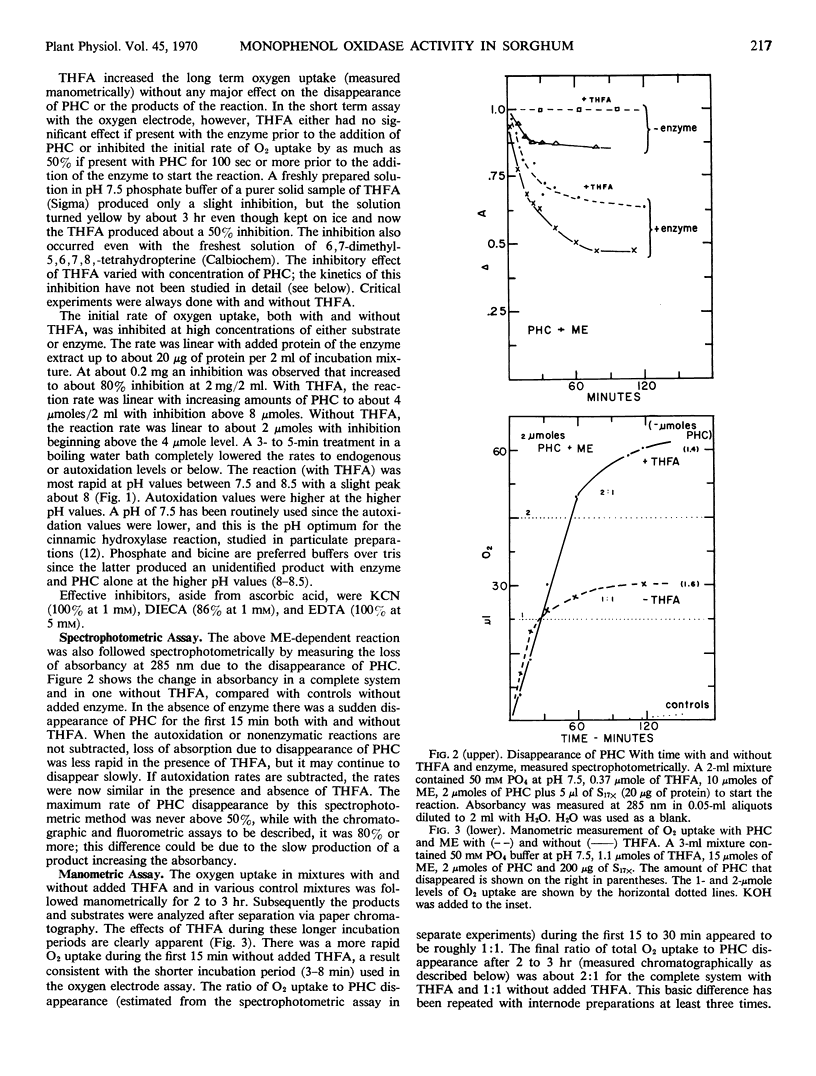Abstract
A p-hydroxycinnamic acid oxidase activity was present in enzyme preparations from first internodes of Sorghum vulgare variety Wheatland milo when incubated in phosphate buffer at pH 7.5. This preparation had no classical polyphenolase activity but had both peroxidase and catalase activities. Since horseradish preparations catalyzed the same reaction, the oxidation probably is another example of a peroxidase-oxidase reaction. A second substrate was p-hydroxyphenylpyruvic acid. Ferulic acid was slightly active at low concentrations and inhibitory at higher ones. Diphenols such as caffeic and chlorogenic acids were inactive and inhibitory to p-hydroxycinnamic acid oxidation. A variety of monophenols such as tyrosine and cinnamic acid were inactive. An active substrate must have a free monophenolic group and para to this a C3 side chain with a double bond and probably a free terminal acid group. A sulfhydryl reducing agent at the 5 millimolar level such as mercaptoethanol, reduced glutathione, or dithiothreitol was obligatory. Products were varied and were found in both the ethyl acetate-soluble and insoluble fractions after acidification of the incubation mixtures. With internode extracts, about 1 micromole of O2 was consumed per micromole of p-hydroxycinnamic acid that disappeared in the presence of mercaptoethanol. Tetrahydrafolic acid plus mercaptoethanol were required for a second step oxidation or a parallel reaction; about 2 micromoles of O2 were consumed per micromole of p-hydroxycinnamic acid that disappeared. Potassium cyanide, diethyldithiocarbamate, ascorbic acid, and ethylenediaminetetraacetate were inhibitory. A similar mercaptoethanol-dependent monophenol oxidase was present in preparations from green shoots that also contained a classical polyphenolase activity. The activity was present in both soluble and particulate (500 to 100,000 gravity) fractions of internodes. Preliminary studies were made of enzyme complexes in the particulate fractions capable of converting phenylalanine and tyrosine to the level of ferulic acid when the above p-hydroxycinnamic acid oxidase was blocked with ascorbic acid. The ratelimiting step was the hydroxylation of p-hydroxycinnamic acid.
Full text
PDF







Selected References
These references are in PubMed. This may not be the complete list of references from this article.
- Hayaishi O., Nozaki M. Nature and mechanisms of oxygenases. Science. 1969 Apr 25;164(3878):389–396. doi: 10.1126/science.164.3878.389. [DOI] [PubMed] [Google Scholar]
- KENTEN R. H., MANN P. J. G. The oxidation of manganese by plant extracts in the presence of hydrogen peroxide. Biochem J. 1949;45(3):255–263. doi: 10.1042/bj0450255. [DOI] [PMC free article] [PubMed] [Google Scholar]
- Petrack B., Sheppy F., Fetzer V. Studies on tyrosine hydroxylase from bovine adrenal medulla. J Biol Chem. 1968 Feb 25;243(4):743–748. [PubMed] [Google Scholar]
- Pierpoint W. S. The enzymic oxidation of chlorogenic acid and some reactions of the quinone produced. Biochem J. 1966 Feb;98(2):567–580. doi: 10.1042/bj0980567. [DOI] [PMC free article] [PubMed] [Google Scholar]
- Stafford H. A. Biosynthesis of phenolic compounds in first internodes of sorghum: lignin and related products. Plant Physiol. 1967 Mar;42(3):450–455. doi: 10.1104/pp.42.3.450. [DOI] [PMC free article] [PubMed] [Google Scholar]
- Stafford H. A. Factors Controlling the Synthesis of Natural and Induced Lignins in Phleum and Elodea. Plant Physiol. 1965 Sep;40(5):844–851. doi: 10.1104/pp.40.5.844. [DOI] [PMC free article] [PubMed] [Google Scholar]
- Stafford H. A. Histochemical & Biochemical Differences Between Lignin-Like Materials in Phleum pratense L. Plant Physiol. 1962 Sep;37(5):643–649. doi: 10.1104/pp.37.5.643. [DOI] [PMC free article] [PubMed] [Google Scholar]
- Vaughan P. F., Butt V. S. The hydroxylation of p-coumaric acid by an enzyme from leaves of spinach beet (Beta vulgaris L.). Biochem J. 1969 Jun;113(1):109–115. doi: 10.1042/bj1130109. [DOI] [PMC free article] [PubMed] [Google Scholar]
- Yokota K., Yamazaki I. Reaction of peroxidase with reduced nicotinamide-adenine dinucleotide and reduced nicotinamide-adenine dinucleotide phosphate. Biochim Biophys Acta. 1965 Aug 24;105(2):301–312. doi: 10.1016/s0926-6593(65)80154-0. [DOI] [PubMed] [Google Scholar]


